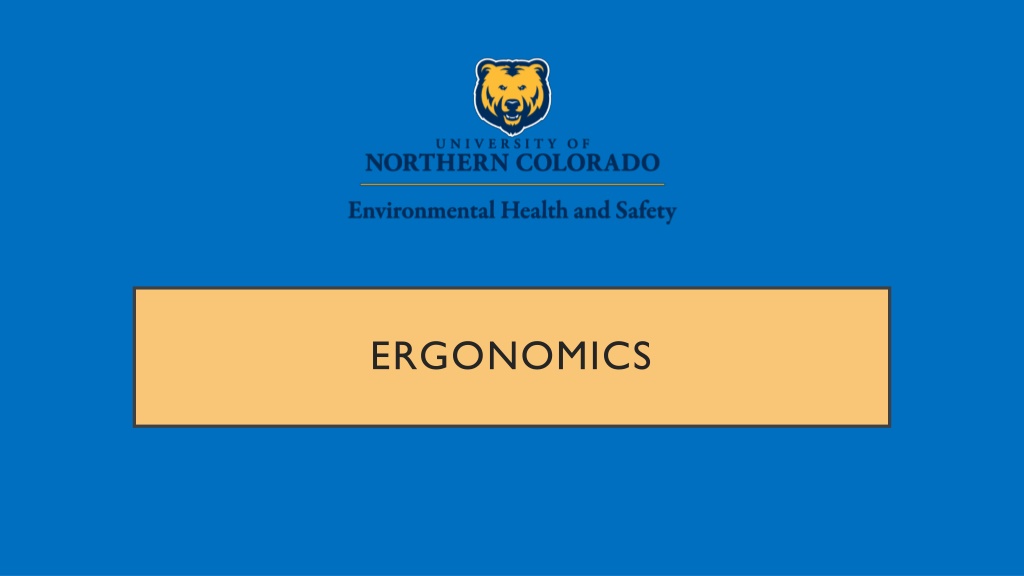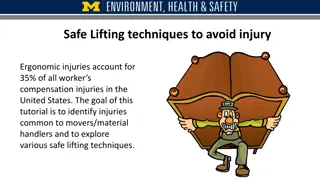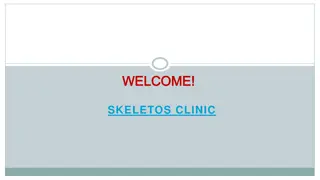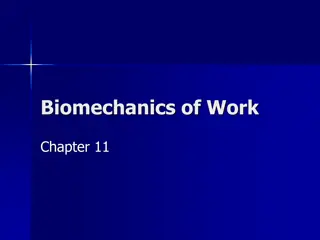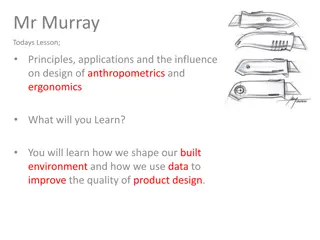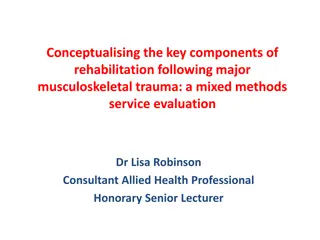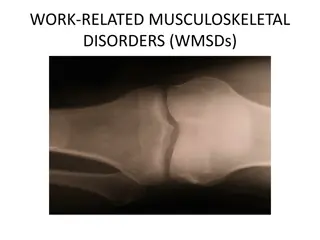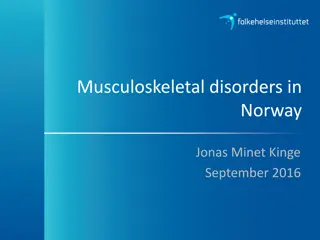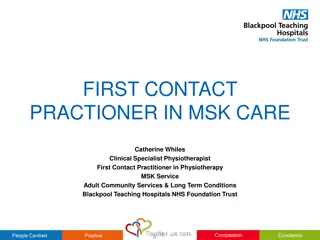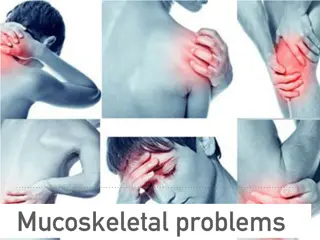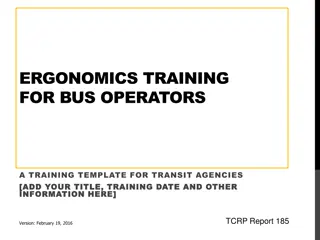Understanding Ergonomics and Preventing Work-Related Musculoskeletal Disorders
Ergonomics focuses on fitting the job to the worker to promote well-being, safety, and productivity. Overexertion and repetitive motion are common causes of workplace injuries. Musculoskeletal disorders affect various body parts, leading to symptoms like pain, numbness, and stiffness. Common work-related MSDs include carpal tunnel syndrome and tennis elbow. Certain areas like the back, arms, and hands are more prone to stress. Risk factors for MSDs include work positions, effort level, and task duration, such as exerting excessive force or working in awkward postures.
Download Presentation

Please find below an Image/Link to download the presentation.
The content on the website is provided AS IS for your information and personal use only. It may not be sold, licensed, or shared on other websites without obtaining consent from the author. Download presentation by click this link. If you encounter any issues during the download, it is possible that the publisher has removed the file from their server.
E N D
Presentation Transcript
Common work-related musculoskeletal disorders (MSDs) Risk factors OVERVIEW Ergonomic control methods
INTRODUCTION Ergonomics can be described as fitting the job to the worker . An ergonomic work system is one that: Promotes human well-being and worker safety Optimizes the productivity and performance of a system or task. Creating an ergonomic work environment may involve: The station at which you work The tools you use during a task Other equipment that may be needed
INTRODUCTION Overexertion is the leading cause of workplace injury. It is costly to employers and can have lasting effects on workers. Repetitive motion is also among the leading causes of workplace injury. Even sitting at your desk, be conscious of your habits!
MSDs affect muscles, nerves, blood vessels, ligaments, and tendons Symptoms of MSDs include: Discomfort Pain Numbness Loss of motion/flexibility Spasticity Stiff joints Burning Swelling Tingling Inflammation Throbbing Paralysis MUSCULOSKELETAL DISORDERS
COMMON WORK RELATED MSDS Carpal Tunnel Syndrome Tennis Elbow Neck strain Tendinitis Back strain Rotator Cuff Trigger Finger Many more
MOST COMMONLY AFFECTED AREAS Certain parts of the body are more prone to work related stresses, these areas include: Back Arms, Elbows, Shoulders Hands, Fingers, Wrists Neck Knees, Ankles, Feet
RISK FACTORS Risk factors for work-related MSDs depend on: Work positions and postures How often a task is performed The level of effort and duration of a task
EXAMPLES OF RISK FACTORS Exerting excessive force Lifting/pushing heavy objects Performing the same task repetitively Working in awkward postures or the same posture for a long period of time Reaching, kneeling, squatting, leaning, bending wrists, etc. Cold temperatures Vibration Hands, arms Whole body Exposure to a combination of these factors can expedite negative symptoms
CONTROL METHODS
ERGONOMIC CONTROL METHODS Establish an ergonomics program Training Conduct job hazard analysis Early recognition and reporting from all levels
PROPER WORK PRACTICES Use proper lifting techniques Team lift particularly heavy or awkwardly shaped items Stretching Implementing a work/rest ratio Task variety, switch back and forth throughout the day.
ENGINEERING CONTROLS Engineering controls involve a physical change to the work station itself, they don t rely on behavioral factors or personnel. Some examples include: Work station design and setup Ergonomically designed tools Ergonomically designed equipment Load weight reduction Elevated work stations Fume hoods Safety cabinets
PERSONAL PROTECTIVE EQUIPMENT PPE can be used as a control method Gripping gloves Knee pads Vibration gloves Thermal gloves Lifting straps Shoulder harness Lifting braces
REPORTING You should report any signs or symptoms you may have to your supervisor if: Pain is persistent, severe or worsening Pain radiates Symptoms include numbness or tingling Symptoms keep you from sleeping at night Fingers blanch or turn white
GET INVOLVED Feel free to offer suggestions and comments to your supervisor or EHS regarding your job. Take pride in the way your job is done. Make it the safest, most efficient system you can! Attend training
QUESTIONS? Thank you for attending this presentation!
